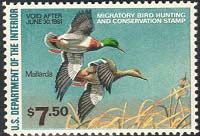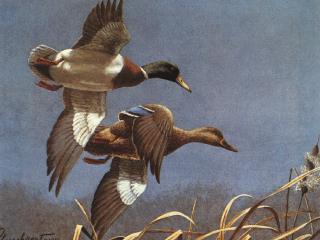

Back to RW47 Back to the Federal Index Home
A LITTLE HISTORY ON THE 47TH (1980-81) DUCK STAMP ARTIST


On April 25, 1941 Richard W. Plasschaert came into the world in a peaceful little community about 75 miles southwest of Minneapolis - New Ulm, Minnesota. Because his father, Maurice, was an Army career man, the military family was constantly on the move. Mr. Plasschaert spent his formative years in Red Bank, New Jersey, and in various parts of the Deep South.
After he graduated from New Ulm High School, Mr. Plasschaert struck out to discover where his talents would take him. For several years he held a series of odd jobs, all of which were art related. During this undecided period in his life, he married Mary Zangel, his high school sweetheart. She became a strong motivating factor in his life, probably more responsible than any other single person for his success.
At one point in his life, he had an agreement with the printer for whom he worked, that he could resign at some point to pursue his ultimate goal of becoming self-employed as a wildlife artist. However, if things didn't go well, the printer promised to hold his job at the print shop open. Mr. Plasschaert took advantage of the agreement twice, and twice returned to the print shop after going broke. He was about to leave the shop for a third time when he received the announcement that he had won the duck Stamp competition.
Painting was not and is still not easy for Mr. Plasschaert, but his patience and perservenance carry him through. He usually spends between 60 and 80 hours a week in his studio working seven days a week more often than not. Because of his hard work, his paintings reflect the talent of an accomplished artist. While he was still searching for his place in the art world, Mr. Plasschaert enlisted in the Minnesota National Guard for a six-year hitch, starting in 1960.
His art does not always reflect his lifelong interest in wildlife. Much of his early work was primarily landscapes and portraits. Of course, his ability at landscape painting was a great asset when he decided to concentrate on paintings of wildlife. The background of a painting quite often determines if it is bound for success or failure.
Mr. Plasschaert gained a fairly good reputation as a landscape artist during his brief periods of free-lancing. He has exhibited in the Audubon show in New York, and most of his paintings sold well in the New York market. He received a great honor when he was accepted into the National Academy.
As a hobby, Mr. Plasschaert enjoys making period furniture. He finds the hobby compliments his painting well, because to be successful at furniture making one must have patience, be able to work with his hands, and be exacting.
--------------------THE ART--------------------
Mallards was painted in full-color acrylic paint. It was printed in four-color photolithography using lightfast inks on Rising Mirage paper. The prints are hand signed in pencil and numbered. The edition was 12,950 regular prints and 250 artist proofs. The image size is 6-1/2" x 9".
--------------------THE STAMP--------------------
Mallards…Engraved by the Federal Bureau of Engraving from the original artwork. Printed in orange, green, brown, yellow, dark blue, light blue, and black ink. The stamp sold for seven dollars and fifty cents. Postal records show 2,103,021 stamps sold. First day of sale was July 1, 1980.
Most of the information contained above is from the book Federal Duck Stamp Story, Fifty Years of Excellence, by Laurence F. Jonson; Alexander & Co. It is used here with permission from the author. For more information on this book, please click here.